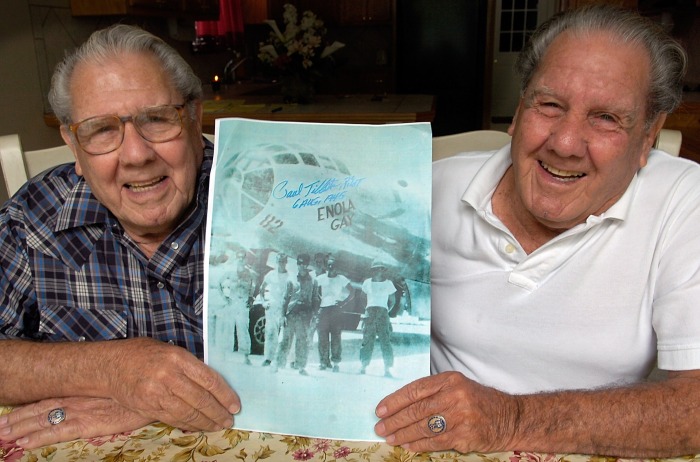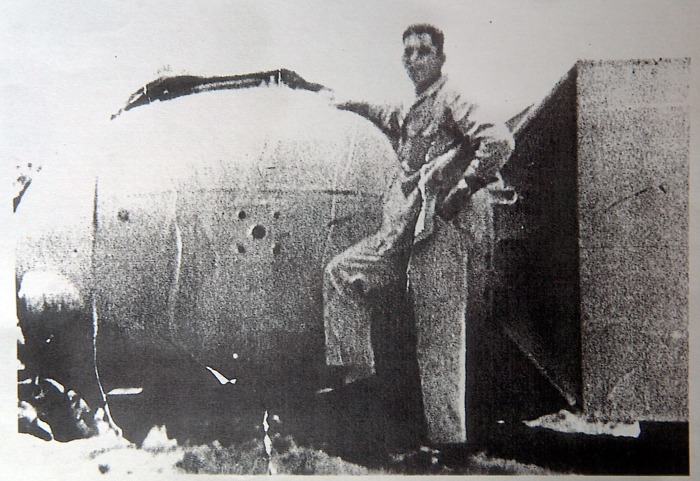
Twins Ben and Joe Graci, originally of New Orleans, hold a photo they are in that was autographed by pilot Paul Tibbets. They served on the Pacific island of Tinian, from which the airplanes took off that dropped both atomic bombs of Japan. (Photo by Bill Feig, used by permission of The Advocate, Baton Rouge, Louisiana)
By George Morris
In the months that twin brothers Joe and Ben Graci of New Orleans worked on the Pacific island of Tinian, Col. Paul Tibbets was just another pilot they knew and the “Enola Gay” was just another bomber that they and their comrades worked to keep flying in World War II.
That changed abruptly on Aug. 6, 1945.
When the B-29 Superfortress bomber flown by Tibbets dropped an atomic bomb code named “Little Boy” on Hiroshima, Japan, it was just as big a surprise to the men on Tinian as it was to the rest of the world. They found out about it the next day.
“Everybody went wild,” Joe Graci said.
On Aug. 9, a second bomb, code named “Fat Man,” was dropped on Nagasaki after the airplane “Bock’s Car” also took off from Tinian, and Japan surrendered five days later.
Joe Graci was an aircraft mechanic. Ben Graci was responsible for all the parachutes for Tinian’s 300 B-29s. Another New Orleanian, Phil Burst, did sheet metal work, including work on the Enola Gay, Joe Graci said.
The Graci brothers enlisted in 1943. Knowing the likelihood that they would be drafted, they enrolled in aircraft mechanics school at Delgado Community College. With that skill, they were immediately sent to the Army Air Force when they enlisted.
To learn about the B-29, they were sent to Tinker Field in Oklahoma. The B-29 was 99 feet long, 29 feet 7 inches high and had a wingspan of 141 feet, 3 inches. Its empty weight was 69,000 pounds.
“They said, ‘We’re going to show you the airplane you’re going to work on,’” Ben Graci said. “They had this big monster in a hangar, and they had a B-17 under one wing and a P-40 underneath the other wing, to give you an idea how big.”
In 1944, the Gracis were shipped to Tinian, which the Marine Corps had captured on Aug. 1, as part of the 20th Air Force, 313th Wing, 40th Bomb Group. Tinian was valued for air bases the Japanese had built and which would be used as a base from which to bomb Japan and support other military missions.
The same was true of Saipan, just six miles north of Tinian, and Guam. Their 57-day voyage included several days of waiting for the island to be secured.
The bombing campaign initially involved high-altitude missions dropping high-explosive ordnance. When that proved ineffective, the B-29s switched to night raids dropping incendiary bombs, which produced devastating firestorms.
In the summer of 1945, however, a different cargo arrived. Only a select few on the island knew what it was, but everyone else wondered. Joe Graci said one of his buddies, whose name he can’t recall, found that the temptation to look at one of the bombs proved irresistible, and Graci agreed to record the moment on film. The photo shows the soldier posing with what they believe was “Fat Man.” (It could have been a training bomb built to the same dimensions as the actual bomb.)
“He says, ‘I’d like to see that bomb.’ I said, ‘You go pull the canvas and I’ll take the picture, and you run like hell,’” Graci said. “That’s how we got the picture. … We could’ve got shot.”

Being on a secure island base, that was about the only way they might have succumbed to hostilities. For many fighting men, the war was a dirty slog. Not so for those on Tinian. They worked regular hours, had hot meals and hot showers. Once a week, they would go fishing on 40-foot boats.
“We had cigarettes. We had all the ice cream we wanted,” Ben Graci said. “We had Coca-Colas, ice. All that was there.”
That relatively cushy lifestyle isn’t something they usually share with other World War II veterans, especially ground troops. Joe Graci recalls being invited to a Veterans of Foreign Wars function when the subject of wartime living conditions came up.
“They were Marines. They said, ‘You had it rough?’ I said, ‘Whew, it was real rough.’ I didn’t tell them nothing,” he said. “We hated to tell people how it was.”
The dropping of the atomic bombs didn’t immediately end work on Tinian. Conventional bombing missions continued. Then, there were missions to airdrop food and medicine to prisoner of war camps.
After the war, the brothers returned to New Orleans and both went to work for the National Guard — Ben as an auditor, Joe in charge of vehicle repair at Jackson Barracks.
The Gracis agree with the decision to drop both of the atomic bombs, something almost universally supported by Americans at the time. Years later, Joe Graci said he spoke to a college audience that had some dissenters.
“One girl got up and said, ‘Don’t you feel sorry for what you all did?’” he said. “I said, ‘No, ma’am. I’d do it all over again.’”
Great story. So many people don’t realize what it takes to keep the pilots flying and the ground soldier fighting.
LikeLike
I have sometimes wondered what people in the USA in 1945 thought about the use of the A-Bombs and the firebombing campaign — I wish I had more data on this (not necessarily from 15-25 or more years after the fact, but views voiced or written at the time). The public in the USA certainly knew about the B-29 firebombings of Japanese cities; for example, The New York Times reported on the firebombing of Tokyo (May ’45) in a large article in their May 30, 1945 issue (this is available online). My grandfather was on Tinian when the A-Bombs went through there (in the ground crew of the XXth, 468th — at West Field), and he certainly never regretted his participation.
LikeLike
Benny & Joseph Graci are my ancestors! They were my grandmother’s cousins. I am the first in my generation to carry that “twin” gene. I gave birth to fraternal twin boys(Jace&Lane). Only after being pregnant with them did I learn about Benny & Joesph and the fact that twins ran in the family. Complete surprise! It’s an honor to see them marked in our history. I’ve heard nothing but wonderful stories about them. I hope my boys grow to be close like Benny & Joesph. So happy to run across this article.
Brittany Guy
LikeLike
I’m glad you liked it. It was a fun interview.
LikeLike